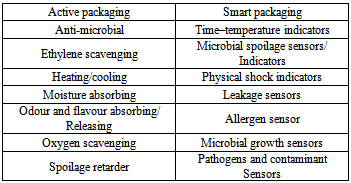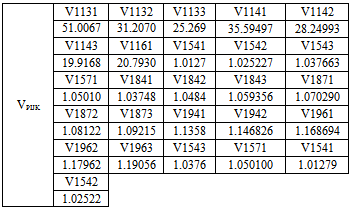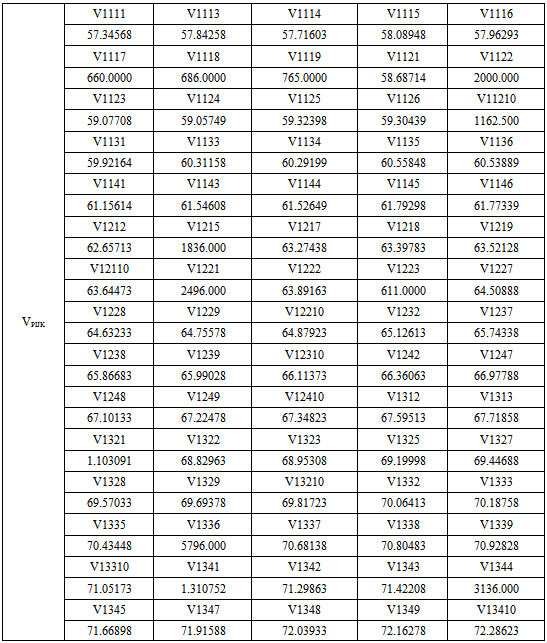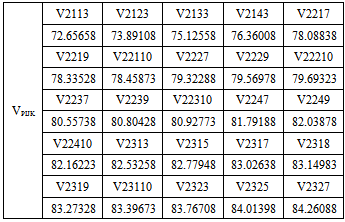-
Paper Information
- Paper Submission
-
Journal Information
- About This Journal
- Editorial Board
- Current Issue
- Archive
- Author Guidelines
- Contact Us
Management
p-ISSN: 2162-9374 e-ISSN: 2162-8416
2014; 4(1): 1-9
doi:10.5923/j.mm.20140401.01
The Performance of Intelligent Packaging in the Planning of Poultry Supply Chain
Dib Zahera1, Bennekrouf Mohammed2, Sari Zaki1
1Laboratoire de Productique de Tlemcen (MELT), Université Abou Bekr Belkaid, Tlemcen, 13000, Algeria
2Ecole préparatoire Science et Technique (EPST), Tlemcen, 13000, Algeria
Correspondence to: Dib Zahera, Laboratoire de Productique de Tlemcen (MELT), Université Abou Bekr Belkaid, Tlemcen, 13000, Algeria.
| Email: |  |
Copyright © 2012 Scientific & Academic Publishing. All Rights Reserved.
This paper describes the principal concept of intelligent packaging linked to the efficiency of natural property of a pack, product, or pack/product configuration in a poultry supply chain. For packaging in the future, intelligent functions of packaging should be integrated in order to inform about the product status. This communication is used in order to provide information on product quality during transport and distribution. Therefore, intelligent packaging can be defined as a system that informs about the product conditions and responds rapidly to changes in internal or external conditions of packaged food. Besides, this designation can be used in a broader sense to include properties related to product identity, authenticity and traceability, as well as safety and quality issues. Multi-sensor technology is suitable for monitoring and protecting food quality in order to detect pathogens, leakages, carbon dioxide, oxygen, and determine pH, time or temperature etc. On the other hand, this technology is to be used as an online quality control tool for the safety and protection of consumers, authorities and food producers. In our work, we will complete the model of ‘F. Boudehri’ by the packaging operation. The object of his study was to renovate the retail distribution system in the city of Tlemcen (Algeria). For this specific case, two types of packaging chicken meat can be used to expand distribution of these products to remote areas such as the southern part of the country. The purpose of the present work is to extend the shelf life of the product with a minimum cost. LINGO optimization solver (Version12) was used to get the solution to the problem.
Keywords: Intelligent packaging, Smart package devices, Agri-foods supply chain, Distribution network, Chicken meat, Slaughterhouses, Optimization
Cite this paper: Dib Zahera, Bennekrouf Mohammed, Sari Zaki, The Performance of Intelligent Packaging in the Planning of Poultry Supply Chain, Management, Vol. 4 No. 1, 2014, pp. 1-9. doi: 10.5923/j.mm.20140401.01.
Article Outline
1. Introduction
- The term agri-food supply chains (ASC) was coined to describe the steps from production to distribution that bring agricultural or horticultural products from the farm to the table[1]. ASC include all the organizations responsible for production (farmers), distribution, processing, and marketing of agricultural products to the final consumers. A supply chain of agri-foods, as any other supply chain, is a network of organizations working together in different processes and activities in order to bring products and services to the market, with the purpose of satisfying customers’ demands[2]. What differentiates ASC from other supply chains is the importance played by factors such as food quality and safety[3]. The food industry has answered the call for diverse choices of convenient food items, with food and beverage packaging paving the way. Packaging materials have traditionally been chosen for convenience and to avoid unwanted interaction with food[4]. In the 20th century, antimicrobials and oxygenscavengers were introduced in packaing developments in order to extend the product lifetime and protect foods from environmental influences. These new packaging systems are called active packaging[5]. Nevertheless, omnipresent global trends such as increased industrial food processing, greater importation and exportation of food products. Lack of time for fresh food preparation pushes the food and beverage packaging industry to search for newer and more advanced packaging solutions to meet the demand for healthier, safer, cheaper, as well as better processed foods. Thus, while protecting and preserving food were once perceived as the principal roles of food packaging[6], facilitating convenience has quickly emerged as equally important. Other elements of increasing importance in food packaging include traceability, tamper indication, and sustainability[7]. These newer packaging systems are called smart or intelligent packaging systems. In this review, we focus on smart packaging aspects that are related to the integration of sensor technology for food quality and safety. Its concept and principle, as well as it applications for food quality and safety are described, including sensors for the detection of microbes and contaminants.This paper focuses on the extension of the supply chain from farmers to customers of chicken, with two types of packaging. First, in the paper presented by[8], the problem of minimizing the recall and the number of batches constituting a given finished product (chopped steak) is studied (the supply chain is represented by the company of production of chopped steak from raw material to finished product (Dupuy)[9]. This product is characterized by 2 stages: assembly and disassembly bill of materials. First, the economical quantity is calculated with Visual Basic then a mathematical Mixed Integer Linear programming model (MILP) is proposed and finally the experimental results obtained using CPLEX software are presented. Second, this supply chain was completed with a forth level witch is the of finished product packaging, illustrated in the research work[10].
2. Improving Traceability
- For some well-known fundamental reasons, such as the repeated crises that question the consumer confidence, globalization and the supply chain complexity, traceability has become a hot and unavoidable topic for all food industries. In addition, the implementation of European Regulations on food security, effective since January 2005, helps elucidate the interest to trace all food data, at each stage of the production process; that is from processing to distribution. However, ‘ISO 8402'[11] certification defines traceability as the ability to trace the history of use or location of an item, or similar activities, by means of recorded identification. It thus allowed monitoring and finding a product or service from its inception until its destruction or consumption. Technology oriented in this direction has developed a crossroads of identifications, such as EDI, barcodes, radio frequency identification, GSM, etc. This ought to be developed to facilitate the tracking of a product and reduce the cost of a traceability system such as in Gandino et al[12]; as well as the Database Development Process (Alfaro and al[13]).The information collected by a traceability system contributes, in a significant way, to the recall of agri-food products in case of crises such as the mad cow crisis, foot and mouth disease, dioxin or GMOs. In this context, our work will help optimize the cost of recall of expired products, referred to in the literature as an essential parameter in the evaluation of the performance and traceability systems and supply chains. For a thorough study of the problem, Moe[14] defines the Traceable Resource Unit (TRU), which is recognized as a homogeneous group of a resource class used / consumed / produced / released by a basic activity in a non-zero finite quantity of this class. TRU is a single unit, i.e. no other unit can have similar or comparable characteristics from the traceability point of view. More specifically, a TRU is a batch production type. Lot identification is usually easy in the case of discrete processes.Conversely, in the case of continuous processes (e.g. in glass industry), identification is more difficult. Kim et al[15] define the basic rules for traceability. For H. M. Kim et al.[15], an ideal traceability system must be able to trace the history of both the products and activities, i.e. TRUs and simple activities. Moe[14] provides a description of these two entities with their descriptors, in food industry. With the help of the semantic model of their ontology and their first-order logic, Kim et al.[15] define the basic rules for traceability: If a TRU is dissociated, the dissociated parts keep the identification of the source TRU. If all TRUs are put together, identification of the new TRU is different from those of the source TRUs. The second term relates to the dispersion of production batches.The problem of performance evaluation and traceability optimization of a production system is discussed in detail by Dupuy and al[9]. Tamayo and al[16] have validated this work for large sizes by using genetic algorithms. Wang and al[17] propose a link between manufacturing performances and traceability optimization, based on batch size and on the dispersion of production batches. Finally, F. Dabbene and al[18] propose a new criterion for measuring and optimizing the performance of a traceability system. P Gay considered the recall cost of food products as a performance of the system traceability and got interested in the link between the raw material and the finished product.
3. Active and Intelligent Packaging
- Intelligent packaging can be defined as a packaging system that is able of carrying out intelligent functions (like detecting, containment, convenience, tracing, communicating, and applying scientific logic). It allows improving decision making in order to extend shelf life, enhance safety, ensure good quality, and provide information. Particularly, integration of smart packaging aims to communicate information on the status of the product, because the package and the food always move together throughout the supply chain cycle. The package is the food’s best companion and is in the best position to communicate the food conditions. Consequently, the IP is placed above the communication function in the model presented in Figure 1, in which the IP is a provider of assured communication and the Active Packaging (AP) is a provider of enhanced protection. Thus, in the entire packaging system, IP is the function responsible for sensing the environment and processing information, and AP is the component in charge of taking some specific tasks (for example, release of an antimicrobial, ...) to protect the food product. Note that the terms IP and AP are not commonly exclusive; some packaging systems may be classified either as IP or AP or both, but this situation does not diminish their usefulness. In certain appropriate situations, IP, AP, and the traditional packaging functions work synergistically to provide a total packaging solution. According to our definition, a package is “intelligent” if it has the ability to track the product, sense the environment inside or outside the package, and communicate with humans. For example, an intelligent package is one that can monitor the quality/safety condition of a food product and provide early warning to the consumer or food manufacturer[19]. We have been vigilant not to introduce other terms such as responsive packaging, diagnostic packaging, and clever packaging, because using too many terms tends to further complicate the already confusing terminology. It is important to emphasize that IP is a system that involves not only the package, but also the food product, the external environment, and other considerations. The emergence of IP lead to another paradigm shift in the concept of food packaging — shifting the package from a mediocre communicator to an intelligent communicator. As alluded to earlier, the purpose of introducing IP is to inspire people to expand the communication function of packaging in an innovative and useful way[20].
 | Figure 1. Model of packaging functions[26] |
|
4. Features of Intelligent Packaging
- Intelligent packaging is considered as a new branch of packaging science and technology that offers several opportunities for enhancing food protection, quality, and convenience. The development in this technology will require researchers to continue to think outside the box and use nontraditional packaging approaches to meet new challenges. There is an important distinction between package functions that are smart, and those that become active in response to a triggering event, for example, filling, exposure to ultraviolet, release of pressure etc., and then continue until the process is exhausted. Figure 1 illustrates the model of packaging function between active packaging and smart packaging[21]. Table 1 presents various types of active packaging that already exist in the market, and intelligent packaging concepts still under development. An illustrative example of active packaging is that of oxygen scavengers that can be used into the packaging system itself; that is sachets or labels are preferably used. One example is the Darex oxygen scavenger that can be incorporated into crowns, cans and a diversity of metal and plastic closure. The system offers flavour stability and extended shelf-life for products such as beer, wine, tomato-based products, fruit drinks, etc.[22]. In other part, a good example of smart packaging is time–temperature indicators (TTIs) that demonstrate irreversible change in a physical feature, usually color or shape, in response to temperature history. These tools are expected to mimic the change of a certain quality parameter of the food product undergoing the same exposure to temperature. Some are designed to monitor the evolution of gases and changes in temperature along the distribution chain, while others are designed to be used in consumer packages. In order to be used as food quality and safety monitoring tools, the change rate in the tool must correlate well with the rate of deterioration of the food product. The rate of tool changes must also correlate with the temperature variation over time during transportation and distribution [23]. While active packaging integrates robust ways to control oxidation, microbial growth, and moisture, intelligent packaging designs facilitate the monitoring of food quality[24]. TTIs, ripeness indicators, chemical sensors, biosensors and RFID are all examples of components in smart packaging. Most of these smart tools have not had widespread commercial application, but two are gaining more notoriety namely TTIs and RFID. TTIs can play a fundamental role in indicating the freshness and safety of a food product. They monitor and communicate which food products are safe to consume, and which are not. This becomes extremely significant as soon as food is stored in less than optimal conditions such as extreme heat or freezing. In the situation of foods that should not be frozen, a TTI can find out whether the food had been improperly exposed to cold temperatures. Conversely, a TTI can also specify whether food sensitive to heat has been exposed to unnaturally high temperatures and its exposure time.Radio frequency identification provides wireless monitoring of food packages through tags, readers, and computer systems. Many of its applications are found in the food industry; they can range from facilitating food traceability to improving the efficiency of supply chains. But perhaps the ultimate advantages of RFID in food packaging are that it speeds stock rotation and improves tracking.RFID systems are beneficial for many food manufacturing operations and supply chains. To develop an intelligent food packaging for food quality and product protection, RFID should be more often implemented in the food industry and incorporated in food science[25]. Retail chains such as Wal-Mart and Home Depot already use RFID, because RFID systems, as they provide protection and security benefits by tracking the food suppliers. Retailers are considering ways to integrate this technology into the management of their supply chains. Intelligent packaging can play an important role in facilitating the flow of both materials and information in the food supply chain cycle. In Figure 2, the outer circles represent the supply chain cycle from raw material through manufacturing, packaging, distribution, product use, and disposal. The package, in one form or another (such as pouch, container, drum, pallet), is traditionally used to facilitate the flow of materials (represented by the arrows in the figure) from one location to another, by performing the essential functions of containment and protection of the product. Moreover, the package can also facilitate the flow of information (represented by the communication links between the inner circle and outer circles), although this communication function has been largely used —it can carry actual information in the direction of material flow (for example, via truck, train, or ship), and it can transmit information visually (for example, via an indicator) or electronically (for example, via a barcode or the Internet) throughout every phase of the supply chain cycle[26].
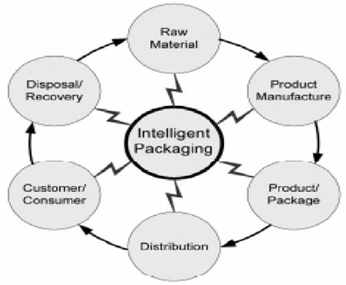 | Figure 2. Material Flow  in the Food Supply Chain Cycle[26]. in the Food Supply Chain Cycle[26]. |
5. Modeling of the Supply Chain
- A given universal production-distribution network with all existing and potential facilities involve three main stages: production stage, distribution stage and customer stage. The network design problem consists in selecting the facilities to open in order to construct a production-distribution system with minimal overall costs and the highest customer service levels[21]. The design problems of supply chains are often complex by nature due to their direct relationship with economic, organizational and social sector. For this reason, the design of a successful logistics network (in its various forms: location, production, distribution, routing, location/ allocation, choice of suppliers, etc. ...) has actually attracted the attention of industrial and scientific community.
5.1. Location Allocation-Problems
- In a location-allocation problem, localization refers to the determination of the location of sites (sites of production or distribution centers), but allocation refers to assigning activities to production sites, distribution centers or customers. This location-allocation problem is defined as follows[22]:Minimize the sum of fixed costs related to production, transportation, and provision of raw materials, while respecting the supply chain capacity.In a previous research work[22], the authors addressed the design problem where plant location and supplier selection decisions are integrated. In this study, they assumed that the retailer would make a random demand for one type of product, and the delivery time between each supplier and the corresponding distribution center (DC) is assumed to be constant. Furthermore, delivery of the product from the distribution center to the customer is done on the same day. The problem is to select suppliers, locate distribution centers and allocate suppliers as well as retailers to distribution centers (DCs), with the aim to minimize the fixed cost of localization of production centers, running inventory and safety stock costs at the distribution centers and transportation costs through the network. The authors found that the problem is NP-hard, and proposed the Lagrangian relaxation approach to solve this problem. The authors presented in their paper[23] a metaheuristic called "Heuristic Concentration (HC)" and showed how this method improves the performance of an exchange heuristic of a single element in solving the problem. The authors of a paper[24] presented a literature review of models of plant location and planning strategies for supply chains. The authors noted the interest shown by several researchers when studying stochastic cases. The authors note that the tactical and operational decisions (routing and mode of transport) strongly depend on the decision of the location of sites and that integration decisions in Supply Chain Management is less studied.
6. Mathematical Model of Location-Allocation Problem
- The Capacitated Plant Location Problem (CPLP) implemented to management this sub problem. The objective of this sub problem is to minimize the following two costs, namely:1. Total Fixed Cost: The fixed cost depends on the sum of the costs necessary for locating and establishing slaughterhouse; it includes land purchase, lease, and property tax etc.,2. Distribution Cost: it is the minimal cost for a vehicle to travel all required distances from the slaughterhouses to their corresponding allocated customers, since a travel distance can be regarded as the surrogate measure for distribution cost.The mathematical model[27] is given as follows:
 The objective function minimizes total costs, which are the sum of fixed facility costs FCi and total demand weighted distance Vlij multiplied by the cost per unit distance per unit demand[27].After studying the location-allocation problems of poultry supply chain, we complete it with the packaging of the final product.
The objective function minimizes total costs, which are the sum of fixed facility costs FCi and total demand weighted distance Vlij multiplied by the cost per unit distance per unit demand[27].After studying the location-allocation problems of poultry supply chain, we complete it with the packaging of the final product. 7. Packaging Model
- Assuming that the plant capacity is unlimited, only one plant can be booked for maximal size batches ordered by customers. Also, the customer can be served periodically by a single plant via a warehouse, where the delay time to serve this intermediate entity is important.For this purpose, some hypotheses are suggested in order to facilitate the problem. First, it is assumed that the time to prepare a product for an order from a customer is quite long. Second, this assumption is valuable only for an intercontinental agri-food industry where the shipment from the plant to the warehouse takes a longer time than from the warehouse to the costumer. The proposed model aims to manage simultaneously the physical product flow between different types of packaging. It presents an extension of the facility location – allocation problem, widely discussed in the literature. The design of the problem consists of the following three basic entities in the production chain, i.e. plant, warehouse and customer.
7.1. Sets and Indices
 warehouse index
warehouse index customer index
customer index packaging index
packaging index plant index (which can represent plants or suppliers),The parameters of the problem are the following:Costp: product packaging costExpp: expiration time of pre-packaged product within the package pCapj: capacity of warehouse JDemk: daily demand of customer kTCostij: unitary transportation cost from plant i to warehouse jTCostjk: unit transportation cost from warehouse j to customer kTimeij: transportation time from plant i to warehouse jLsizeik: maximum lot size of a product that can be delivered from plant i to customer kPeriodik: period of time that plant i needs to serve customer kThe decision variable of problem:Affectik= 1, if plant i is assigned to customer k, 0 otherwiseopenpik:=1, if packaging p from plant i is assigned to customer k , 0 otherwiseVolpijk: volume shipped from plant i to customer k via warehouse j pre-packaged in type p The function Z2 minimizes the transportation cost and packaging cost:
plant index (which can represent plants or suppliers),The parameters of the problem are the following:Costp: product packaging costExpp: expiration time of pre-packaged product within the package pCapj: capacity of warehouse JDemk: daily demand of customer kTCostij: unitary transportation cost from plant i to warehouse jTCostjk: unit transportation cost from warehouse j to customer kTimeij: transportation time from plant i to warehouse jLsizeik: maximum lot size of a product that can be delivered from plant i to customer kPeriodik: period of time that plant i needs to serve customer kThe decision variable of problem:Affectik= 1, if plant i is assigned to customer k, 0 otherwiseopenpik:=1, if packaging p from plant i is assigned to customer k , 0 otherwiseVolpijk: volume shipped from plant i to customer k via warehouse j pre-packaged in type p The function Z2 minimizes the transportation cost and packaging cost: | (1) |
 | (2) |
 | (3) |
 | (4) |
 | (5) |
 | (6) |
 | (7) |
 | (8) |
 | (9) |
 | (10) |
8. Numerical Example Illustration
- Lingo 12 solver was used in the simulation modeling. Supposing that the problem is NP only, for a small size, the calculation time takes 30 min when thirteen (13) 2.2 GHZ CPUs are used. For further explanation of the results, tables 3 and 4 give the binary decision variable and optimal affected volume from open plant i to customer k via warehouse j and the type of appropriate package p.The simulation of the mathematical model developed involves two parts. The first table shows the results of simulation of a small region with three customers close to the distribution centers. The second simulation is for a larger area that involves more customers located at a farther distance from the warehouse. The use of IP is required in remote areas such as the south, in order to extend the life of a product and protect it in case of a fire.
8.1. Simulation Model in the First Region
- In this section, firstly the supply network is composed of 16 candidate facilities with horizon periods of delivery to each customer, 2 possibilities of packaging the product and 3 customers which can be connected to 7 warehouses. The input used in this example is as shown below:
|
|
|
8.2. Simulation Model in the Second Region
- In this section, firstly the supply network is composed of 3 candidate facilities with horizon periods of delivery to each customer, 2 possibilities of packaging the product, and 10 customers which can be connected to 4 warehouses. The input used in this example is as shown below:
|
|
|
9. Conclusions
- The location-allocation problem is an elementary strategic study to ensure a sustainable supply chain. In the agri-food supply chain, an improved packaging such as IP is an important parameter for ensuring a good quality of the product and extending its lifetime. For this reason, it can be seen that the introduction of packaging is necessary, not only during production but also at a strategic level of wide order area of consumer supervision. In this study, the advantage of intelligent packaging is explained in the problem of delivery. Firstly, an optimal network of primary first consumer is established. Next, a bi-objective model is presented; it minimizes the cost of shipment from the first costumer to the second, where the delivery time is long. It would be more beneficial to investigate the problems of multi-period multi-product (MPMP) production planning. Metaheuristics are used to solve large size problems.
 Abstract
Abstract Reference
Reference Full-Text PDF
Full-Text PDF Full-text HTML
Full-text HTML